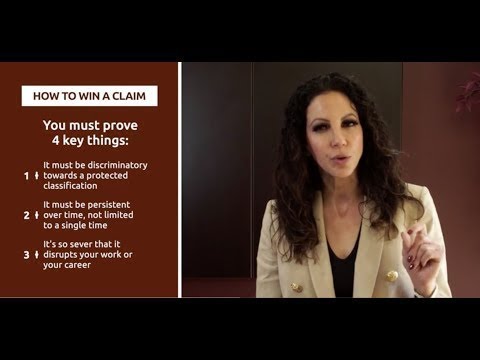
Welcome to this informative article on understanding your rights when it comes to suing for a hostile work environment in New York. It’s important to note that while this article aims to provide you with helpful insights, it is always recommended to cross-reference the information with other sources or seek guidance from legal advisors. Now, let’s delve into the fascinating world of workplace rights and how they apply in the context of a hostile work environment case in New York.
Understanding Hostile Work Environment Claims in New York: A Comprehensive Guide
Understanding Your Rights: Suing for Hostile Work Environment in New York
Introduction:
📋 Content in this article
In the state of New York, employees have certain rights when it comes to a safe and inclusive work environment. One of these rights is protection against a hostile work environment. If an employee feels harassed, discriminated against, or subjected to offensive behavior at work, they may have grounds to sue their employer for creating or permitting a hostile work environment. This article aims to provide a comprehensive guide on understanding your rights and the process of suing for a hostile work environment in New York.
What is a Hostile Work Environment?
A hostile work environment refers to a workplace in which unwelcome conduct based on race, gender, age, religion, disability, or other protected characteristics unreasonably interferes with an employee’s ability to perform their job. It is important to note that isolated incidents or simple teasing may not meet the legal definition of a hostile work environment. The behavior must be severe and pervasive enough to create an abusive or intimidating working environment.
Elements of a Hostile Work Environment Claim:
To successfully sue for a hostile work environment in New York, you must be able to establish the following elements:
1. Unwelcome Conduct: The behavior must be unwelcome and unwanted. It can include verbal or physical harassment, offensive jokes, derogatory comments, slurs, insults, or any other form of conduct that creates an uncomfortable or hostile atmosphere.
2. Based on Protected Characteristics: The unwelcome conduct must be based on protected characteristics such as race, sex, religion, national origin, age, disability, or other legally recognized categories.
3. Severe and Pervasive: The conduct must be severe and pervasive enough to alter the conditions of employment and create an abusive or intimidating workplace.
4.
Understanding the Elements of a Hostile Work Environment Claim in US Law
Understanding the Elements of a Hostile Work Environment Claim in US Law
In the United States, employees have rights that protect them from working in a hostile environment. A hostile work environment is a term used to describe a workplace where an employee is subjected to unwelcome conduct based on their protected characteristics, such as race, gender, religion, disability, or age. If you are experiencing such a hostile work environment in New York, it’s essential to understand your rights and the elements required to bring a claim.
Elements of a Hostile Work Environment Claim:
To establish a claim for a hostile work environment, you need to fulfill certain elements. These elements, when proven, can help support your case. The key elements typically include:
1. Unwelcome Conduct: The conduct or behavior you are facing must be unwelcome and offensive to you. This means that you did not invite or willingly participate in the conduct that created the hostile work environment.
2. Based on Protected Characteristics: The conduct must be based on your protected characteristics, such as race, gender, religion, disability, or age. It is crucial to show that the hostility you face is due to one or more of these protected characteristics.
3. Severe or Pervasive: The unwelcome conduct must be severe or pervasive enough to create an abusive work environment. An isolated incident, unless particularly severe, may not be enough to establish a hostile work environment claim.
4. Interference with Work Performance: The hostile work environment must be interfering with your ability to perform your job effectively. This means that the conduct is affecting your productivity, well-being, or mental health.
5. Employer Liability: To hold your employer responsible for the hostile work environment, you need to show that they knew or should have known about the misconduct and failed to take appropriate action.
Title: Understanding Your Rights: Suing for Hostile Work Environment in New York
Introduction:
In today’s workplace, it is crucial to understand your rights and protections as an employee. One important aspect of employment law is the concept of a hostile work environment. This article aims to provide a comprehensive overview of suing for a hostile work environment in New York. However, it is essential to remember that laws can change or vary, so it is imperative to verify and cross-reference the information provided here with current legal resources.
1. Defining a Hostile Work Environment:
A hostile work environment refers to a workplace environment where an employee is subjected to discriminatory or harassing behavior that is severe, pervasive, and interferes with their ability to perform their job. It is crucial to note that not all unpleasant or offensive conduct qualifies as a hostile work environment under the law.
2. Federal and State Laws:
In the United States, both federal and state laws protect employees from hostile work environments. Federal laws, such as Title VII of the Civil Rights Act of 1964, prohibit workplace discrimination based on race, color, religion, sex, or national origin. In addition, the New York State Human Rights Law provides broader protections, including additional categories such as age, disability, sexual orientation, gender identity, and more.
3. Elements of a Hostile Work Environment Claim:
To successfully sue for a hostile work environment, certain elements must be established:
